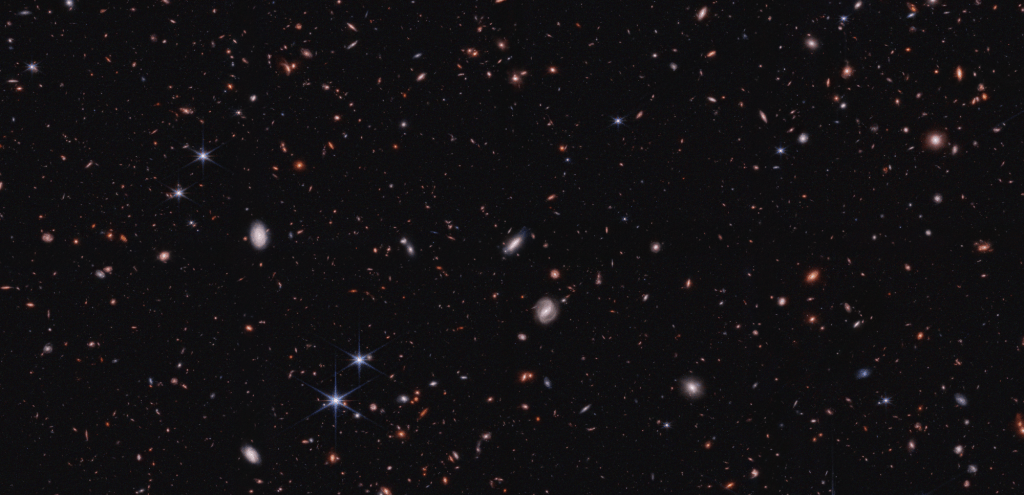NASA’s James Webb Space Telescope (JWST) has recently provided an extraordinary glimpse into the universe through its Near-Infrared Camera (NIRCam), capturing a small portion of the field for the Cosmic Evolution Early Release Science (CEERS) survey. This monumental achievement in space observation is poised to enhance our understanding of cosmic evolution and the intricate mechanisms at play in the universe.
The CEERS survey aims to explore the early stages of the universe, focusing on the formation and development of galaxies. The images captured by JWST are expected to offer unprecedented clarity and detail, enabling scientists to delve deeper into the mysteries of the cosmos. The specific portion of the field observed by NIRCam is just a fraction of the extensive area the telescope will study, promising a wealth of data and insights.
The James Webb Space Telescope: A Brief Overview
The James Webb Space Telescope is a collaborative project involving NASA, the European Space Agency (ESA), and the Canadian Space Agency (CSA). Designed to succeed the Hubble Space Telescope, JWST is equipped with advanced instruments that allow it to observe the universe in the near-infrared spectrum. This capability is crucial because it enables the telescope to peer through cosmic dust clouds and observe objects that are too old or too distant for Hubble to detect.
NIRCam, one of the primary instruments on JWST, plays a pivotal role in this mission. It is designed to capture high-resolution images in the near-infrared range, which is essential for studying the early universe. By observing in this spectrum, NIRCam can detect light from the first galaxies that formed after the Big Bang, providing valuable data on their formation and evolution.
The CEERS Survey: Unveiling Cosmic Mysteries
The Cosmic Evolution Early Release Science (CEERS) survey is one of the first major research projects utilizing JWST. Its primary goal is to investigate how galaxies have evolved over time, from the early universe to the present day. The survey will focus on several key areas of study, including the formation of galaxies, the role of dark matter, and the influence of supermassive black holes.
The recent image captured by NIRCam is a testament to the telescope’s capabilities. It showcases a small portion of the survey field, revealing an array of galaxies at various stages of development. Each point of light in the image represents a galaxy, some of which are billions of light-years away. This level of detail is unprecedented, offering scientists a new perspective on the universe’s structure and composition.
Technical Jargon Explained
For those unfamiliar with the technical terms, here’s a brief explanation:
- Near-Infrared Camera (NIRCam): This is a specialized camera on JWST that captures images in the near-infrared part of the electromagnetic spectrum. Infrared light has longer wavelengths than visible light, allowing it to penetrate through cosmic dust and gas clouds, revealing objects that are otherwise hidden.
- Cosmic Evolution Early Release Science (CEERS) survey: This is a research project aimed at studying the early stages of the universe by observing distant galaxies. The data collected will help scientists understand how galaxies formed and evolved over billions of years.
- Light-year: A unit of distance used in astronomy, representing the distance light travels in one year. One light-year is approximately 5.88 trillion miles (9.46 trillion kilometers).
The Importance of Near-Infrared Observation
Observing the universe in the near-infrared spectrum offers several advantages. First, it allows astronomers to see through cosmic dust clouds that can obscure objects in visible light. This is particularly important when studying regions of star formation, where dense clouds of gas and dust are present.
Second, near-infrared light can travel vast distances without being significantly absorbed or scattered. This means that NIRCam can detect light from the earliest galaxies that formed after the Big Bang, providing a glimpse into the universe’s infancy. By studying these ancient galaxies, scientists can gain insight into the processes that shaped the cosmos.
Reactions and Implications
The release of the NIRCam image has generated excitement within the scientific community. Researchers are eager to analyze the data and extract valuable information about the observed galaxies. The clarity and detail of the image have exceeded expectations, reinforcing the significance of JWST’s mission.
Astronomers and astrophysicists are particularly interested in the potential discoveries that JWST can facilitate. The telescope’s ability to observe the early universe could lead to breakthroughs in our understanding of cosmic evolution. For instance, by studying the formation of the first galaxies, scientists can test existing theories and develop new models to explain the universe’s development.
Good to Know: The Role of International Collaboration
The success of the James Webb Space Telescope is a testament to the power of international collaboration. NASA, ESA, and CSA have worked together to design, build, and launch this cutting-edge observatory. Each agency has contributed expertise, funding, and resources, demonstrating the importance of global cooperation in addressing complex scientific challenges.
ESA’s contributions include the Ariane 5 rocket that launched JWST, as well as the development of some of the telescope’s instruments. CSA provided the Fine Guidance Sensor (FGS) and the Near-Infrared Imager and Slitless Spectrograph (NIRISS), both of which are critical for the telescope’s operations.
Looking Ahead: Future Observations and Discoveries
The recent image from NIRCam is just the beginning of JWST’s journey. Over the coming months and years, the telescope will continue to observe the universe, providing a wealth of data for scientists to analyze. The CEERS survey is just one of many research projects that will benefit from JWST’s capabilities.
Future observations are expected to cover a wide range of topics, from the formation of stars and planetary systems to the study of exoplanets and their atmospheres. By examining these diverse phenomena, JWST will help answer fundamental questions about the universe and our place within it.
Conclusion
The James Webb Space Telescope’s recent achievement, capturing a detailed image of a small portion of the CEERS survey field, marks a significant milestone in our quest to understand the universe. The data provided by NIRCam offers a new window into the early stages of cosmic evolution, allowing scientists to explore the formation and development of galaxies with unprecedented clarity.
As JWST continues its mission, the scientific community eagerly anticipates the discoveries that lie ahead. The telescope’s advanced capabilities and international collaboration have set the stage for a new era of astronomical research, promising to unveil the secrets of the cosmos and expand our knowledge of the universe.
In summary, the image captured by NASA’s James Webb Space Telescope’s NIRCam for the CEERS survey is a remarkable achievement, providing valuable insights into the early universe. This milestone underscores the importance of near-infrared observation and international collaboration in advancing our understanding of cosmic evolution. With JWST’s continued observations, we are on the brink of new discoveries that will shape our understanding of the universe for years to come.
For more Information, Refer to this article.


































